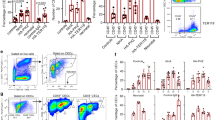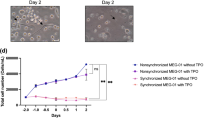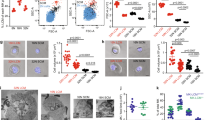Abstract
While the terminal stages of erythroid differentiation are regulated by the hormone erythropoietin, the early stages of proliferation and differentiation of immature erythroid progenitor cells also depend on cellular factors functionally defined as burst-promoting activity (BPA)1–4. Thus, in vitro there is suboptimal development of primitive erythroid progenitor cells (burst-forming units—erythroid, BFU-E) into colonies unless a source of BPA is added. It has been demonstrated that T cells5–8 and monocytes8–10 produce BPA. Monocytes may represent the main source of BPA and the major role of T cells may be to augment BPA production by monocytes10. Irradiated bone marrow cells, which contain T cells, monocytes and other BPA-producing cells, also promote BFU-E colony formation11. As these studies used crude BFU-E populations as target cells, it was not possible to define which of the accessory cell products act directly on the progenitor cell. Here we have used a panel of monoclonal antibodies to purify BFU-E from peripheral blood. We demonstrate that BPA produced by both a monocyte and a T-cell line acts directly on the erythroid progenitor cell and can support colony formation by single BFU-E.
This is a preview of subscription content, access via your institution
Access options
Subscribe to this journal
Receive 51 print issues and online access
$199.00 per year
only $3.90 per issue
Buy this article
- Purchase on Springer Link
- Instant access to full article PDF
Prices may be subject to local taxes which are calculated during checkout
Similar content being viewed by others
References
Iscove, N. N. Cell Tissue Kinetics 10, 323–334 (1977).
Mara, H. & Ogawa, M. Expl Haemat. 5, 141–148 (1977).
Iscove, N. N. ICN – UCLA Symp. molec. cell. Biol. Vol?, 37–82 (1978).
Tsang, R. W. & Aye, M. T. Expl Haemat. 7, 383–388 (1979).
Nathan, D. G. et al. J. exp. Med. 147, 324–329 (1978).
Mangan, K. F. & Desforges, J. F. Expl Haemat. 8, 717–727 (1980).
Torok-Storb, B. J., Martin, P. J. & Hansen, J. A. Blood 58, 171–174 (1981).
Reid, C. D. L., Baptista, L. C. & Chanarin, I. Br. J. Haemat. 58, 171–174 (1981).
Gordon, L. I., Miller, W. J., Branda, R. F., Zanjani, E. D. & Jacob, H. S. Blood 55, 1047–1050 (1980).
Zuckerman, K. S. J. clin. Invest. 67, 702–709 (1981).
Linch, D. C., Lipton, J. M. & Nathan, D. G. J. clin. Invest. (submitted).
Golde, D. W., Bersch, N., Quan, S. G. & Lusis, A. J. Proc. natn. Acad. Sci. U.S.A. 77, 593–596 (1980).
Abboud, C. N., Brennan, J. K., Barlow, G. H. & Lichtman, M. A. Blood 58, 1148–1154 (1981).
Indivieri, F., Wilson, B. S., Pellegrino, M. A. & Ferrone, S. J. immun. Meth. 29, 101–104 (1979).
Griffin, J. D., Beveridge, P. & Schlossman, S. F. Blood 60, 30–35 (1982).
Nissen, C., Moser, Y. & Speck, B. Br. J. Haemat. 51, 385–390 (1982).
Beverley, P. C. L. & Callard, R. F. Eur. J. Immun. 11, 329–334 (1981).
Wisniewski, D., Platsoucas, C., Strife, A., Lambek, C. & Clarkson, B. Expl Haemat. 10, 817–829 (1982).
Nadler, L. M. et al. J. Immun. 126, 1941–1947 (1981).
Beverley, P. C. L., Linch, D. C. & Delia, D. Nature 287, 332 (1980).
Iscove, N. N., Sieber, F. & Winterhaller, K. H. J. cell. Physiol. 83, 309–320 (1974).
Nadler, L. M. et al. Hum. Immun. 1, 77–90 (1980).
Author information
Authors and Affiliations
Rights and permissions
About this article
Cite this article
Linch, D., Nathan, D. T cell and monocyte-derived burst-promoting activity directly act on erythroid progenitor cells. Nature 312, 775–777 (1984). https://doi.org/10.1038/312775a0
Received:
Accepted:
Issue Date:
DOI: https://doi.org/10.1038/312775a0
This article is cited by
-
Effect of cimetidine on burst-promoting activity of normal T lymphocytes
Annals of Hematology (1992)
-
The control of proliferation and differentiation of early erythroid progenitors
Biotherapy (1990)
-
Stimulation of haematopoiesis in primates by continuous infusion of recombinant human GM-CSF
Nature (1986)
Comments
By submitting a comment you agree to abide by our Terms and Community Guidelines. If you find something abusive or that does not comply with our terms or guidelines please flag it as inappropriate.



